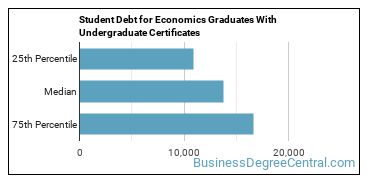Undergraduate Certificates in Economics
Featured schools near , edit
Education Levels of Economics Majors
In 2020-2021, 6 earned their undergraduate certificate in economics. The following table shows the number of diplomas awarded in economics at each degree level.
| Education Level | Number of Grads |
|---|---|
| Bachelor’s Degree | 39,397 |
| Master’s Degree | 4,803 |
| Associate Degree | 3,446 |
| Doctor’s Degree | 1,248 |
| Graduate Certificate | 122 |
| Basic Certificate | 33 |
| Undergraduate Certificate | 6 |
Earnings of Economics Majors With Undergraduate Certificates
The median salary for graduates holding an undergraduate certificate in economics is $60,797. However, this can depend on a number of factors, such as where you live and the number of years experience you have. A better approximation of salary is to look at the typical range of salaries. In this case the low is $60,797 and the high is $60,797.

Student Debt
The median student debt for graduates holding an undergraduate certificate in economics is $21,500. The length of time it takes you to graduate and what college you attend can affect this number quite a bit. The chart below shows the range of accumulated debt loads. On the high side of the range, $21,500 is the debt load, and the debt load on the low side is $21,500.

Student Diversity
More men than women pursue undergraduate certificates in economics. About 66.7% of graduates in this field are male.
| Gender | Number of Grads |
|---|---|
| Men | 4 |
| Women | 2 |

The racial-ethnic distribution of economics undergraduate certificate students is as follows:
| Race/Ethnicity | Number of Grads |
|---|---|
| Asian | 0 |
| Black or African American | 0 |
| Hispanic or Latino | 0 |
| White | 5 |
| International Students | 0 |
| Other Races/Ethnicities | 1 |

Economics Focus Areas
| Major | Annual Degrees Awarded |
|---|---|
| General Economics | 6 |
Explore Major by State
Alabama
Arkansas
Connecticut
Florida
Idaho
Iowa
Louisiana
Massachusetts
Mississippi
Nebraska
New Jersey
North Carolina
Oklahoma
Rhode Island
Tennessee
Vermont
West Virginia
References
*The racial-ethnic minority student count is calculated by taking the total number of students and subtracting white students, international students, and students whose race/ethnicity was unknown. This number is then divided by the total number of students at the school to obtain the percentage of racial-ethnic minorities.
- College Factual
- National Center for Education Statistics
- O*NET Online
- Bureau of Labor Statistics
- Image Credit: By pixabay under License
More about our data sources and methodologies.
Featured Schools
You have goals. Southern New Hampshire University can help you get there. Whether you need a bachelor's degree to get into a career or want a master's degree to move up in your current career, SNHU has an online program for you. Find your degree from over 200 online programs.
Visit School
